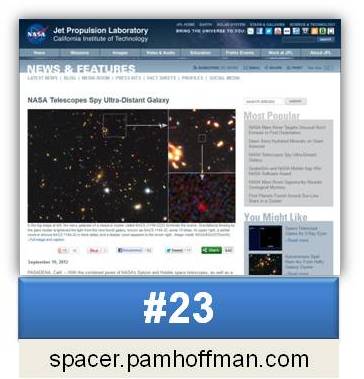NASA Telescopes Spy Ultra-Distant Galaxy
 Two things today.
Two things today.
First, by looking far away, we’re seeing back in time (more details below and on the site). The recently discovered galaxies appear to be from very early in the life of the universe.
Second, I found out about these discoveries because I subscribed to get the messages and you can too!
Here’s what such a message looks like by email…
JPLNewsroom@jpl.nasa.gov
JPL/NASA NewsNews release: 2012-294 Sept. 19, 2012
NASA Telescopes Spy Ultra-Distant Galaxy
The full version of this story with accompanying images is at:
http://www.jpl.nasa.gov/news/news.php?release=2012-294&cid=release_2012-294
PASADENA, Calif. — With the combined power of NASA’s Spitzer and Hubble space telescopes, as well as a cosmic magnification effect, astronomers have spotted what could be the most distant galaxy ever seen. Light from the young galaxy captured by the orbiting observatories first shone when our 13.7-billion-year-old universe was just 500 million years old.
The far-off galaxy existed within an important era when the universe began to transit from the so-called cosmic dark ages. During this period, the universe went from a dark, starless expanse to a recognizable cosmos full of galaxies. The discovery of the faint, small galaxy opens a window onto the deepest, most remote epochs of cosmic history.
“This galaxy is the most distant object we have ever observed with high confidence,” said Wei Zheng, a principal research scientist in the department of physics and astronomy at Johns Hopkins University in Baltimore who is lead author of a new paper appearing in Nature. “Future work involving this galaxy, as well as others like it that we hope to find, will allow us to study the universe’s earliest objects and how the dark ages ended.”
Light from the primordial galaxy traveled approximately 13.2 billion light-years before reaching NASA’s telescopes. In other words, the starlight snagged by Hubble and Spitzer left the galaxy when the universe was just 3.6 percent of its present age. Technically speaking, the galaxy has a redshift, or “z,” of 9.6. The term redshift refers to how much an object’s light has shifted into longer wavelengths as a result of the expansion of the universe. Astronomers use redshift to describe cosmic distances.
Unlike previous detections of galaxy candidates in this age range, which were only glimpsed in a single color, or waveband, this newfound galaxy has been seen in five different wavebands. As part of the Cluster Lensing And Supernova Survey with Hubble Program, the Hubble Space Telescope registered the newly described, far-flung galaxy in four visible and infrared wavelength bands. Spitzer measured it in a fifth, longer-wavelength infrared band, placing the discovery on firmer ground.
Objects at these extreme distances are mostly beyond the detection sensitivity of today’s largest telescopes. To catch sight of these early, distant galaxies, astronomers rely on gravitational lensing. In this phenomenon, predicted by Albert Einstein a century ago, the gravity of foreground objects warps and magnifies the light from background objects. A massive galaxy cluster situated between our galaxy and the newfound galaxy magnified the newfound galaxy’s light, brightening the remote object some 15 times and bringing it into view.
Based on the Hubble and Spitzer observations, astronomers think the distant galaxy was less than 200 million years old when it was viewed. It also is small and compact, containing only about 1 percent of the Milky Way’s mass. According to leading cosmological theories, the first galaxies indeed should have started out tiny. They then progressively merged, eventually accumulating into the sizable galaxies of the more modern universe.
These first galaxies likely played the dominant role in the epoch of reionization, the event that signaled the demise of the universe’s dark ages. This epoch began about 400,000 years after the Big Bang when neutral hydrogen gas formed from cooling particles. The first luminous stars and their host galaxies emerged a few hundred million years later. The energy released by these earliest galaxies is thought to have caused the neutral hydrogen strewn throughout the universe to ionize, or lose an electron, a state that the gas has remained in since that time.
“In essence, during the epoch of reionization, the lights came on in the universe,” said paper co-author Leonidas Moustakas, a research scientist at NASA’s Jet Propulsion Laboratory, a division of the California Institute of Technology in Pasadena, Calif.
Astronomers plan to study the rise of the first stars and galaxies and the epoch of reionization with the successor to both Hubble and Spitzer, NASA’s James Webb Telescope, which is scheduled for launch in 2018. The newly described distant galaxy will likely be a prime target.
For more information about Spitzer, visit http://www.nasa.gov/spitzer . For more information about Hubble, visit: http://www.nasa.gov/hubble .
Whitney Clavin 818-354-4673
Jet Propulsion Laboratory, Pasadena, Calif.
whitney.clavin@jpl.nasa.gov
J.D. Harrington 202-358-5241
NASA Headquarters, Washington
j.d.harrington@nasa.gov
When you visit the JPL page, look for the word ‘Subscribe’ in the blue band across from “News & Features” header if you want to get these messages for yourself!
NOTES:
*Internet access
*Anyone who can read
*No monetary cost, just time
Sources
*http://www.jpl.nasa.gov/news/news.php?release=2012-294&cid=release_2012-294






































